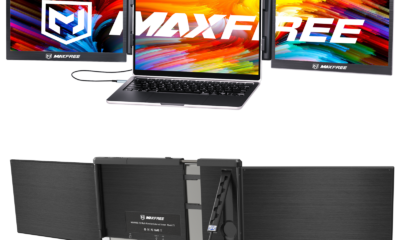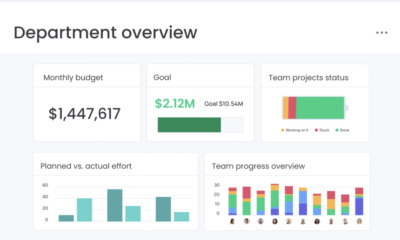Politics
Daolar Portable EV Charger | Review
Published
9 months agoon
By
Drew Simpson
With the rise of electric vehicles (EVs) and plug-in hybrid electric vehicles (PHEVs), the demand for efficient and versatile EV charging solutions has grown exponentially.
In response to this trend, Daolar has introduced a cutting-edge product – the WIFI Control 40A / 48A Portable EV Charger. This EV charging station boasts a plethora of features, making it a compelling choice for EV owners seeking a reliable and user-friendly charging solution.
In this review, we delve into the various aspects of this charger, exploring its unique functionalities, compatibility with different EV models, safety features, and overall performance.
Check out the charger on Daolar
Dual Functionality: Portable & Wall-mounted
One standout feature of the Daolar EV Charger is its dual functionality, serving both as a portable charger and a wall-mounted unit. This versatility allows users to carry the charger during travels and then easily mount it at home for regular charging. It comes equipped with a controller bracket and cable holder, ensuring convenient storage and portability.
Adjustable Current for Optimal Charging
The ability to adjust the charging current is a key advantage of this EV charger. Users can select from multiple Amp ratings (48/40/32/24/16/10A), catering to different charging requirements and power availability. Additionally, for on-the-go charging, an NEMA 5-15P to 14-50R adapter is needed.
Built-in WiFi for Seamless Control
Daolar’s EV Charger takes convenience to the next level with its built-in WiFi functionality. By connecting your smartphone to the charger’s WiFi, you gain real-time access to vital charging information, including status, charging time, and adjustable current settings. However, it’s important to note that the WiFi is exclusively for control purposes and does not provide internet access.
Enhanced Safety Features
Safety is paramount when dealing with electrical devices, especially EV chargers. The Daolar EV Charger incorporates multiple safety mechanisms, such as overvoltage protection, undervoltage protection, overcurrent protection, residual current protection, pen fault protection, and overtemperature protection. These features safeguard both the vehicle and the charger, providing peace of mind during the charging process.
Scheduled Charging for Optimal Efficiency
An invaluable feature of the Daolar EV Charger is its scheduled charging capability. Users can set a departure time for their EV, and the charger will ensure that the vehicle is fully charged before the specified time. Additionally, the controller box allows users to take advantage of lower electricity rates during off-peak hours, optimizing charging efficiency and cost-effectiveness.
User-Friendly Colorful Screen
The EV charger is equipped with a 2.4-inch colorful screen that provides dynamic and intuitive display of essential charging parameters. These include real-time current, voltage, power, charger capacity, control box temperature, and charging status. The vibrant screen enhances user interaction and simplifies monitoring.
Broad Compatibility
Daolar’s commitment to compatibility shines through in its EV charger. The product is designed to be compatible with most SAE J1772 compliant electric vehicles, spanning a range of well-known brands such as BMW, Hyundai, Nissan, Ford, Chevrolet, Audi, Porsche, Kia, and more. This wide compatibility ensures that the charger caters to a broad spectrum of EV owners.
Easy Installation Guidelines
For safe and efficient installation, Daolar recommends the use of a NEMA 14-50 receptacle at home. The charger is designed to plug into any NEMA 14-50 receptacle effortlessly. Users are advised to consult an electrician to install the receptacle, ensuring it matches the charger’s rating for optimal performance and safety.
Specifications and Warranty
The Daolar EV Charger boasts impressive specifications, including adjustable charging current (48/40/32/24/16/10A), maximum power of 11KW, voltage range of 110~240V, and Wi-Fi connectivity at 2.4GHz. It is built to withstand various environmental conditions, with an IP rating of IP65 and a working temperature range of -30℃ to 55℃. Daolar offers a generous 2-year warranty, ensuring customers have peace of mind when investing in their EV charging solution.
Frequently Asked Questions
1. Is the Daolar EV Charger suitable for both home and on-the-go charging?
Yes, the Daolar EV Charger offers dual functionality, making it suitable for both home and on-the-go charging. It can be easily carried during travels and used as a portable charger. At home, it can be conveniently wall-mounted using the provided controller bracket and cable holder.
2. Can I adjust the charging current according to my EV’s requirements?
Absolutely! The Daolar EV Charger allows you to adjust the charging current in multiple steps (48/40/32/24/16/10A). This feature enables you to optimize charging speed based on your vehicle’s power requirements and the available electrical capacity.
3. How do I control the charger and monitor the charging status remotely?
The Daolar EV Charger comes with built-in WiFi connectivity. By connecting your smartphone to the charger’s WiFi network, you can remotely monitor and control the charging process. You can check the charging status, adjust the rated current, and set scheduled charging times using the dedicated smartphone app or the control box.
4. Is the Daolar EV Charger safe to use with my electric vehicle?
Absolutely! Safety is a top priority for Daolar, and the EV Charger is equipped with various protection functions. These include overvoltage protection, undervoltage protection, overcurrent protection, residual current protection, pen fault protection, and overtemperature protection. These safety features ensure both the EV and the charger are safeguarded during the charging process.
5. Can I schedule the charging time to take advantage of off-peak electricity rates?
Yes, the Daolar EV Charger offers scheduled charging capabilities. You can set a departure time for your EV, and the charger will ensure that the vehicle is fully charged before the specified time. Additionally, the controller box can be programmed to respond to start charging times set by the EV, allowing you to take advantage of lower electricity rates during off-peak hours.
6. Is the Daolar EV Charger compatible with my electric vehicle model?
Daolar’s EV Charger is designed to be compatible with most SAE J1772 compliant electric vehicles. This includes popular models from brands such as BMW, Hyundai, Nissan, Ford, Chevrolet, Audi, Porsche, Kia, and many more. It caters to a broad spectrum of EV owners, making it suitable for a wide range of electric vehicles.
7. What power requirements does the Daolar EV Charger have?
The power requirements for the Daolar EV Charger vary depending on the selected charging current. For a 40A output, it requires a dedicated 240V 50A breaker. For 32A, a dedicated 240V 40A breaker is needed, for 24A, a dedicated 240V 30A breaker, and for 16A output, a dedicated 20A breaker. It is essential to confirm your home breaker and choose the appropriate Amp version before placing an order.
8. Is the Daolar EV Charger easy to install?
For safe and efficient installation, it is recommended to install a NEMA 14-50 receptacle at home. The charger is designed to plug into any NEMA 14-50 receptacle effortlessly. To ensure proper installation, it is advisable to consult an electrician who can install a compatible receptacle based on the charger’s rating.
9. What is the warranty period for the Daolar EV Charger?
Daolar offers a generous 2-year warranty for the EV Charger. This warranty provides peace of mind to customers, ensuring that the product is backed by the manufacturer’s commitment to quality and performance.
10. How long does shipping take, and is it available internationally?
The Daolar EV Charger is shipped from the US and typically takes 2 to 7 days for delivery within the country. As for international shipping, it is advisable to check with the manufacturer or the retailer for specific shipping options and availability.
Conclusion
In conclusion, the WIFI Control 40A / 48A Portable EV Charger from Daolar presents an innovative and comprehensive solution for EV owners seeking a reliable, user-friendly, and adaptable charging station.
Its dual functionality, adjustable current settings, built-in WiFi, enhanced safety features, scheduled charging capabilities, and broad compatibility make it a standout product in the EV charging market. With a focus on user convenience, safety, and performance, Daolar’s EV charger is a compelling choice for any electric vehicle owner.
As the world continues its shift towards sustainable transportation, products like Daolar’s EV charger play a pivotal role in facilitating the widespread adoption of electric mobility.
Aleksey Salaz
Aleksey Salaz is a product review staff writer at ReadWrite. He enjoys diving deep into technology and being curious about the newest tech products. For the last 10 years, he has used and tested various tech products from drones to fridges to e-bikes.
Politics
Fintech Kennek raises $12.5M seed round to digitize lending
Published
7 months agoon
10/11/2023By
Drew Simpson
London-based fintech startup Kennek has raised $12.5 million in seed funding to expand its lending operating system.
According to an Oct. 10 tech.eu report, the round was led by HV Capital and included participation from Dutch Founders Fund, AlbionVC, FFVC, Plug & Play Ventures, and Syndicate One. Kennek offers software-as-a-service tools to help non-bank lenders streamline their operations using open banking, open finance, and payments.
The platform aims to automate time-consuming manual tasks and consolidate fragmented data to simplify lending. Xavier De Pauw, founder of Kennek said:
“Until kennek, lenders had to devote countless hours to menial operational tasks and deal with jumbled and hard-coded data – which makes every other part of lending a headache. As former lenders ourselves, we lived and breathed these frustrations, and built kennek to make them a thing of the past.”
The company said the latest funding round was oversubscribed and closed quickly despite the challenging fundraising environment. The new capital will be used to expand Kennek’s engineering team and strengthen its market position in the UK while exploring expansion into other European markets. Barbod Namini, Partner at lead investor HV Capital, commented on the investment:
“Kennek has developed an ambitious and genuinely unique proposition which we think can be the foundation of the entire alternative lending space. […] It is a complicated market and a solution that brings together all information and stakeholders onto a single platform is highly compelling for both lenders & the ecosystem as a whole.”
The fintech lending space has grown rapidly in recent years, but many lenders still rely on legacy systems and manual processes that limit efficiency and scalability. Kennek aims to leverage open banking and data integration to provide lenders with a more streamlined, automated lending experience.
The seed funding will allow the London-based startup to continue developing its platform and expanding its team to meet demand from non-bank lenders looking to digitize operations. Kennek’s focus on the UK and Europe also comes amid rising adoption of open banking and open finance in the regions.
Featured Image Credit: Photo from Kennek.io; Thank you!
Radek Zielinski
Radek Zielinski is an experienced technology and financial journalist with a passion for cybersecurity and futurology.
Politics
Fortune 500’s race for generative AI breakthroughs
Published
7 months agoon
10/11/2023By
Drew Simpson
As excitement around generative AI grows, Fortune 500 companies, including Goldman Sachs, are carefully examining the possible applications of this technology. A recent survey of U.S. executives indicated that 60% believe generative AI will substantially impact their businesses in the long term. However, they anticipate a one to two-year timeframe before implementing their initial solutions. This optimism stems from the potential of generative AI to revolutionize various aspects of businesses, from enhancing customer experiences to optimizing internal processes. In the short term, companies will likely focus on pilot projects and experimentation, gradually integrating generative AI into their operations as they witness its positive influence on efficiency and profitability.
Goldman Sachs’ Cautious Approach to Implementing Generative AI
In a recent interview, Goldman Sachs CIO Marco Argenti revealed that the firm has not yet implemented any generative AI use cases. Instead, the company focuses on experimentation and setting high standards before adopting the technology. Argenti recognized the desire for outcomes in areas like developer and operational efficiency but emphasized ensuring precision before putting experimental AI use cases into production.
According to Argenti, striking the right balance between driving innovation and maintaining accuracy is crucial for successfully integrating generative AI within the firm. Goldman Sachs intends to continue exploring this emerging technology’s potential benefits and applications while diligently assessing risks to ensure it meets the company’s stringent quality standards.
One possible application for Goldman Sachs is in software development, where the company has observed a 20-40% productivity increase during its trials. The goal is for 1,000 developers to utilize generative AI tools by year’s end. However, Argenti emphasized that a well-defined expectation of return on investment is necessary before fully integrating generative AI into production.
To achieve this, the company plans to implement a systematic and strategic approach to adopting generative AI, ensuring that it complements and enhances the skills of its developers. Additionally, Goldman Sachs intends to evaluate the long-term impact of generative AI on their software development processes and the overall quality of the applications being developed.
Goldman Sachs’ approach to AI implementation goes beyond merely executing models. The firm has created a platform encompassing technical, legal, and compliance assessments to filter out improper content and keep track of all interactions. This comprehensive system ensures seamless integration of artificial intelligence in operations while adhering to regulatory standards and maintaining client confidentiality. Moreover, the platform continuously improves and adapts its algorithms, allowing Goldman Sachs to stay at the forefront of technology and offer its clients the most efficient and secure services.
Featured Image Credit: Photo by Google DeepMind; Pexels; Thank you!
Deanna Ritchie
Managing Editor at ReadWrite
Deanna is the Managing Editor at ReadWrite. Previously she worked as the Editor in Chief for Startup Grind and has over 20+ years of experience in content management and content development.
Politics
UK seizes web3 opportunity simplifying crypto regulations
Published
7 months agoon
10/10/2023By
Drew Simpson
As Web3 companies increasingly consider leaving the United States due to regulatory ambiguity, the United Kingdom must simplify its cryptocurrency regulations to attract these businesses. The conservative think tank Policy Exchange recently released a report detailing ten suggestions for improving Web3 regulation in the country. Among the recommendations are reducing liability for token holders in decentralized autonomous organizations (DAOs) and encouraging the Financial Conduct Authority (FCA) to adopt alternative Know Your Customer (KYC) methodologies, such as digital identities and blockchain analytics tools. These suggestions aim to position the UK as a hub for Web3 innovation and attract blockchain-based businesses looking for a more conducive regulatory environment.
Streamlining Cryptocurrency Regulations for Innovation
To make it easier for emerging Web3 companies to navigate existing legal frameworks and contribute to the UK’s digital economy growth, the government must streamline cryptocurrency regulations and adopt forward-looking approaches. By making the regulatory landscape clear and straightforward, the UK can create an environment that fosters innovation, growth, and competitiveness in the global fintech industry.
The Policy Exchange report also recommends not weakening self-hosted wallets or treating proof-of-stake (PoS) services as financial services. This approach aims to protect the fundamental principles of decentralization and user autonomy while strongly emphasizing security and regulatory compliance. By doing so, the UK can nurture an environment that encourages innovation and the continued growth of blockchain technology.
Despite recent strict measures by UK authorities, such as His Majesty’s Treasury and the FCA, toward the digital assets sector, the proposed changes in the Policy Exchange report strive to make the UK a more attractive location for Web3 enterprises. By adopting these suggestions, the UK can demonstrate its commitment to fostering innovation in the rapidly evolving blockchain and cryptocurrency industries while ensuring a robust and transparent regulatory environment.
The ongoing uncertainty surrounding cryptocurrency regulations in various countries has prompted Web3 companies to explore alternative jurisdictions with more precise legal frameworks. As the United States grapples with regulatory ambiguity, the United Kingdom can position itself as a hub for Web3 innovation by simplifying and streamlining its cryptocurrency regulations.
Featured Image Credit: Photo by Jonathan Borba; Pexels; Thank you!
Deanna Ritchie
Managing Editor at ReadWrite
Deanna is the Managing Editor at ReadWrite. Previously she worked as the Editor in Chief for Startup Grind and has over 20+ years of experience in content management and content development.












